Understanding the Research Needs of Reed College Students | Full Report
Printable Report (PDF)
Introduction
E2S seeks to support mid-level students as they make the transition from the first-year experience and work to gain the skills they’ll need to succeed as independent scholars. In this context, research competencies are broadly conceived, starting with the basic aspects of finding and using information. Additional research skills include incorporating information sources in addition to texts, such as media and data, and using various technologies effectively to enable collaboration, analysis, visualization, and presentation.
The body of research from Project Information Literacy (projectinfolit.org) shows that students often struggle with the conceptual aspects of finding context and framing a research question. While an abundance of information literacy programs have focused on the mechanics of mastering complicated systems to locate resources, many students are struggling even to get started. The explosion of information resources available to students has actually made this problem worse. Add to that a wide array of technology devices, apps, and cloud services, and the challenges compound exponentially.
Faculty perspectives are critical to the student research process. Faculty set expectations for student success, and their recommendations for resources and strategies carry a lot of weight. Students are pragmatic about how technology will help them achieve their academic goals and they are interested in guidance from instructors on what is useful (see 2013 ECAR student study).
The ultimate purpose of this needs assessment, then, is to understand the gap between faculty and student perspectives on the research process. The insights gained from this analysis will enable CIS and the library, working in partnership with faculty, to identify strategies for supporting all facets of student research at Reed.
Research Questions
The following research questions guided the needs assessment:
- How do undergraduates learn to do research?
- What do faculty expect?
- What is challenging for students?
- What services and resources would help?
Methods
The needs assessment was completed in two phases:
- Phase I - Focus Groups
- 3 faculty groups with 19 participants from 14 disciplines
- 3 student groups with 17 sophomores & juniors from 14 disciplines
- Phase 2 - Student Survey
- Survey based on information gathered in faculty and student focus groups
- 178 out of 657 sophomores and juniors responded (27%)
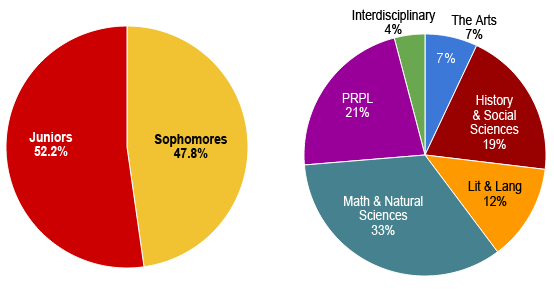
Student Survey Respondents - Year in School and Major (by Division)
More information on the needs assessment focus groups and survey are available in the Needs Assessment Methods section.
Summary of Results
Faculty Perspectives
Across diverse disciplines, faculty stressed the importance of the research question, which guides the research process from literature review to analysis and presentation. Lacking a good research question, students spend too much time conducting “endless lit reviews” and may run out of time for integration and analysis.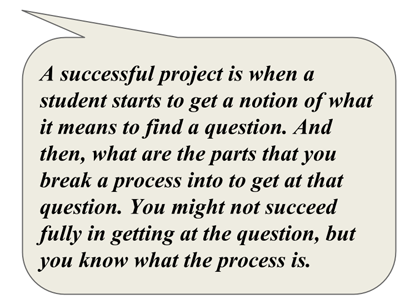
Students need enough discipline-specific context to ask meaningful questions and to think like a scholar in that field. In many cases, students also need to acquire specific techniques and methods, such as laboratory techniques, mathematical analysis, programming, foreign language fluency, or expertise with specialized software.
Faculty often feel challenged by time constraints and widely varying student experience to teach the mix of content, skills, and methods that enable students to successfully engage in the research process.
Student Experiences and Perspectives
Student technology
Consistent with the 2013 student mobile device survey, nearly all students own a laptop computer. The majority of student computers are Macintosh-based, but a significant minority use Windows (28%) or linux (6%) (categories are not mutually exclusive, since about 10% of respondents own more than one laptop).
Smartphone ownership is also quite high, especially compared to student ownership of tablets and dedicated eReaders such as Kindle and Nooks. As with laptops, Apple products are the majority in each category, though there is a significant minority market share, especially of Android products.
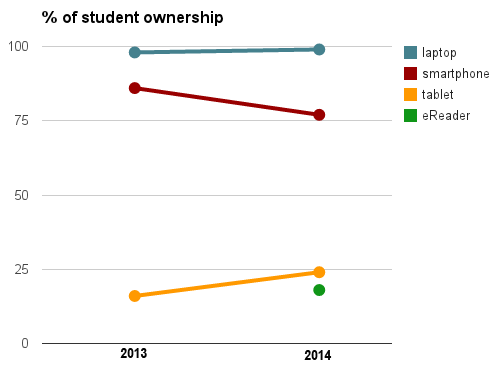
Student Device Ownership - 2013 (from Mobile Device Survey) and 2014 (from Needs Assessment Survey)
Reed student technology ownership patterns are consistent with those reported in the 2013 EDUCAUSE Study of Undergraduate Students and Information Technology (see ECAR 2013 student study, pg. 26).
When asked to rate their technology expertise, Reed sophomores and juniors mostly view their technology skills as comparable or slightly better than their peers. Fewer than 14% feel their technology skills are worse than their peers.
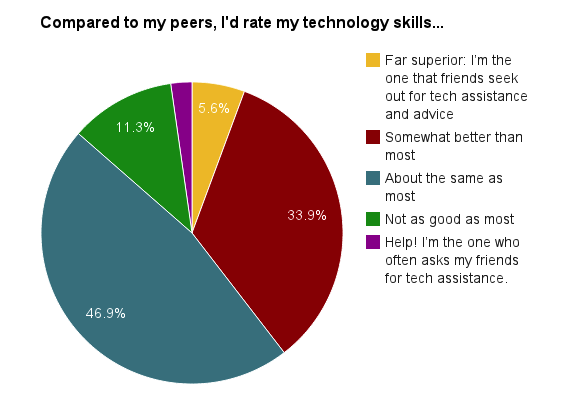
Student Assessments of Their Technology Skills
Student research experiences
Students participate in a wide variety of research assignments. The most common assignment is a research proposal (74%) followed by oral presentations (63%), “close reading” or interpretation of texts (63%), literature review (62%), and an argument about an issue or topic (57%). Slightly more than half the students had assignments such as lab reports, analysis exercises (e.g., problem sets), and annotated bibliographies.
While faculty placed great emphasis on the research question, only 58% of students identified it as important to faculty. Students were more likely to emphasize the products of research, such as a clear argument and good writing, though they also recognize that many faculty expect reasonable amount of effort—not necessarily a perfect product. Relatively few students think that faculty are looking for a certain number or quality of sources in a research assignment.
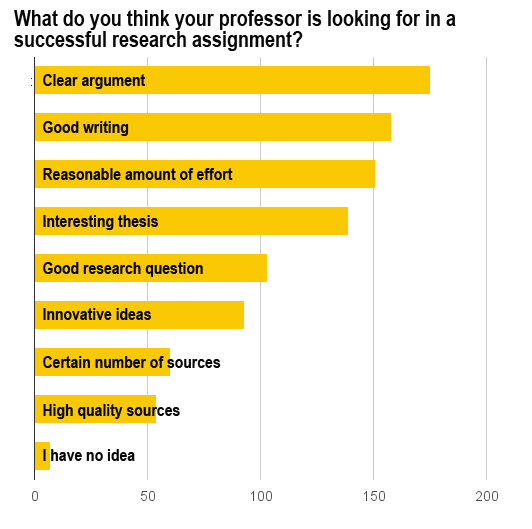
Sources students use
When getting started on a research assignment, students are most likely to search library databases. They also review course readings for ideas, discuss ideas with friends, and consult their professors at least sometimes, but they rarely consult library research guides. Consistent with their inclination to search library databases, when they’re gathering information and data, students usually discover and refine search terms and look for citations in articles they have read. Most students do not use citation management software to organize their resources as they work.
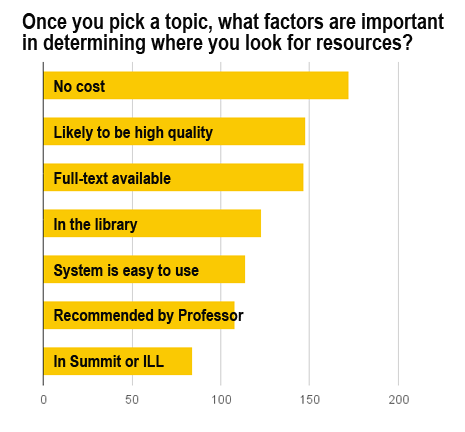
While some studies, such as Project Information Literacy, find that students rely heavily on Google, Reed students expressed strongly divergent opinions on the value of Google as a scholarly resource. Fewer than half the students “usually” use Google Scholar and some of the focus group participants opined that it wasn’t especially useful as a scholarly resource. On the other hand, some students felt they could find anything they need via Google.
For many mid-level students it can be especially challenging to delve into a research topic if they don’t have sufficient background to understand the scholarly context. Google and Wikipedia both serve as a useful starting point and to provide background information and links to relevant articles. However, faculty expressed some frustration that students default to using Google when more discipline-specific databases would be more efficient and relevant.